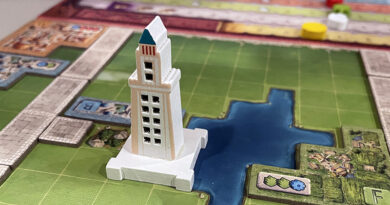878: Vikings – Invasion of England board game review
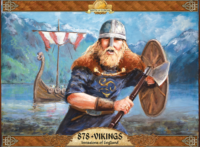
Three years ago as we approached the 4th of July, we reviewed a historically-themed board game from Academy Games called 1775: Rebellion about America breaking away from England rule.
Today we’re taking a look at another historically-themed game about England. But this time it’s to help the English ward off the invading Vikings from the north in 878: Vikings – Invasion of England.
1,140 years ago, in May of 878, Alfred the Great defeated the Vikings at the Battle of Edington. Later that year, the Treaty of Wedmore was agreed whereby the Vikings were able to remain in control of much of northern and eastern England.
When I was young, I thought history was boring. But that has changed tremendously over the years. And when I find a good board game that can bring together historical settings with fantastic game play, I’m super excited.
The beauty of Academy Games is that they deliver on both accounts!
Even if you don’t know anything about the Viking invasion of England (or care to), the game is still loads of fun. But chances are that once you start playing, you’ll discover an urge to find out more about the actual setting you’re playing around with.
How to play 878: Vikings – Invasion of England
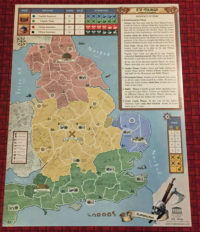
878: Vikings is a game for 2-4 players where players either control the invading Viking or the English nobles trying to withstand the invasion. There are 4 factions in the game. When playing a full 4-player game, it will be a team game of 2 vs. 2. When playing with 2 players, each player will control the 2 factions of their chosen side and coordinate their strategies. When playing with 3 players, simply choose which player will control both factions from one side of the conflict.
Viking players either play as Norsemen Viking freeman or as the fearless Viking shock troops known as Berserkers. The English play as the Housecarl, the Kings’ household troops, or as the Thegns who were regional noble Leaders. The English players will also be able to call up the peasant levies, called the Fyrd, to defend their cities.
The objective is to control the most cities by the time the Treaty of Wedmore is signed.
Set Up
Once players have picked their sides and factions, the game set up is pretty straightforward. Simply follow the diagram in the opening spread of the rulebook.
Some of the Shires on the board are marked with colored unit icons on the top of a circle. These are the English set up locations where starting miniatures are placed. Then each English faction places 4 additional units of any color in any Shire they choose.
The Round pawn is placed on space 1 of the Round track at the top of the board and the Black (Norsemen) Turn cube is placed on the first Turn space. The other 3 colored Turn cubes are placed in the draw bag.
The Viking Leader cards are shuffled by letter on the back and formed a deck – with the first card, letter A, being placed face up. This is Halfdan’s Great Heathen Host leader that will begin with the first invasion.
Each player begins by drawing 3 cards into hand from their faction deck.
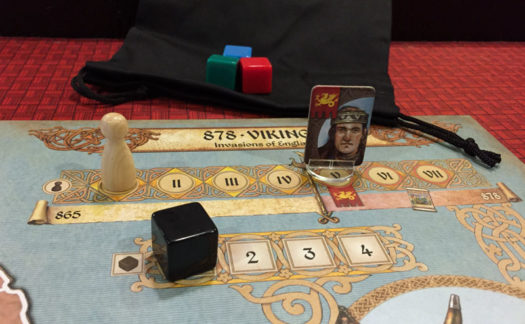
Game Turns
The game is played for up to 7 rounds. In each round, the 4 factions will take turns in random order. At the start of each round, a colored faction cube is drawn from the bag and placed on the next Turn space. The player controlling this faction completes their turn before the next faction cube is drawn.
Each turn consists of 5 phases.
1. Reinforcements Phase: For the Vikings, the first Viking faction to go, draws the top Viking Leader card and places that leader token and the listed number of miniatures on the card. For the English, some Shires depict reinforcement units. If the English control that Shire, the active English player places an indicated reinforcement. Fled units are also re-enter play during this phase. To end the phase, the active player plays a Movement card from their hand.
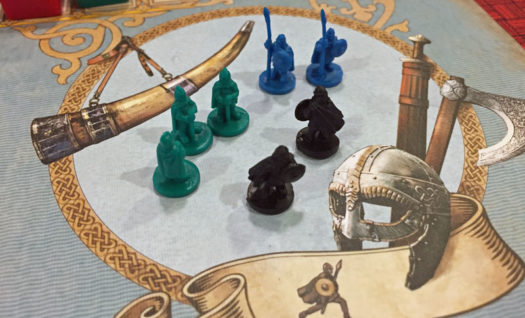
2. Leaders Phase: A Leader’s Army is made up of all units on the associated Leader card. All Leaders move and battle before those without leaders move and battle. A player may move units from a Leader card and the Shire the leader occupies during their movement. They may pick up and drop off units before he moves, as he moves, or after he moves.
A leader battles immediately when he moves into a Shire occupied by enemy units. If the leader wins the battle and still has units on his card as well as movement remaining, he can continue to move. If he doesn’t eliminate defending units on the first battle dice roll, one of the leader’s remaining moves is used up. If a leader has no friendly units left on his card or in the Shire he’s in, he is defeated and removed from the game.
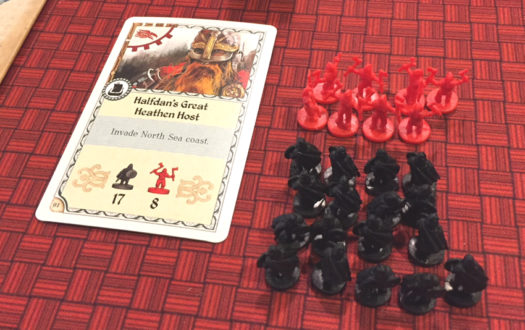
3. Movement Phase: Armies can be formed by all friendly units in a Shire. To move, the army must have at least one of the active player’s faction units in it. The player chooses which armies to move based on the Movement card he played. The top number on the card is the maximum number of armies he may move. The bottom number is how many Shires each army may move. And army may only be moved once during a turn.
An army must stop if it enters a Shire occupied by enemy units. Armies can’t drop off or pick up units while moving.
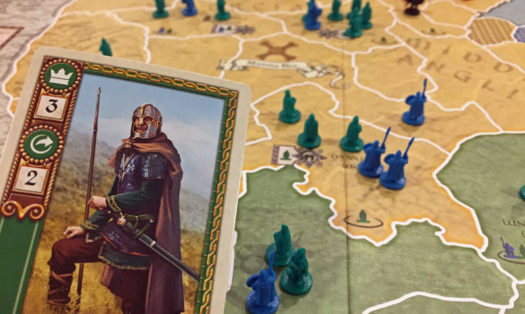
4. Battle Phase: This is the heart of the game as factions fight for control of the Shires.
After movement, there may be a number of Shires with opposing units in them. If this is the case, the active player chooses the order in which battles are resolved.
If the English are defending a City Shire with at least one Housecarl or Thegn, they may also draw one Fyrd card. The card will indicate how many Fyrd units that are added to the English side of the battle. At the end of battle, any remaining Fyrd are removed from the map to their stockpile.
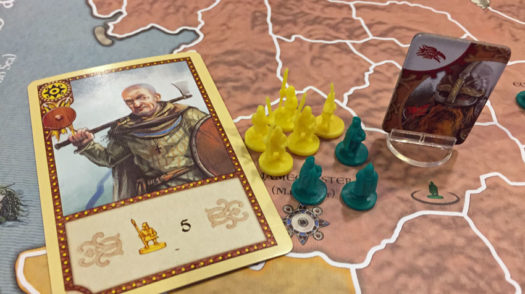
In a battle, the defending units simultaneously roll their Battle Dice first and carry out the results. If units from both sides remain in the Shire, the attacking factions simultaneously roll their Battle Dice. Each faction rolls the number of dice corresponding to the number of units they have in battle (up to a max of number of dice they have available).
Each faction has different probabilities on their dice of Hit, Flee, and Command.
For each Hit, an opposing unit is removed (the effected side chooses which to remove) and is placed back in the reinforcements stockpile.
For each Flee, that faction removes one of its own units and places it in the Fled Units space.
For each Command, that faction may move one of its own units from the battle to any adjacent Shire that contains units of its side.
Battles continue until the Shire only has one side’s units remaining.
After battling, if Vikings occupy a City Shire and no English units are present, the Vikings take a Viking Control marker from the lowest space on the Victory track at the bottom of the board and place it on the City Shire. If that Shire is ever devoid of Viking units or leaders, the control marker is returned to the Victory Track.
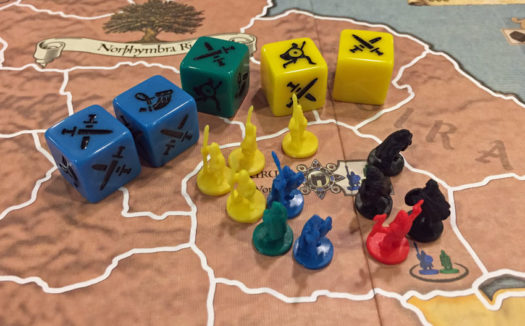
5. Draw Cards Phase: As the name implies, a player ends their turn by drawing back up to a hand of 3 cards. If the player doesn’t have any Movement cards in hand, they must show their cards, reshuffle them back into their deck and draw a new hand of 3 cards.
After all factions have had a turn, the round ends and game end conditions are checked. If the game doesn’t end, a new round begins.
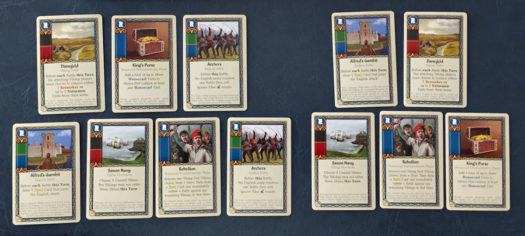
Game End
If there are 14 or more Viking Control markers on City Shires at the end of any round, the Vikings immediately win.
If there aren’t any Viking Control markers on the map at the end of any round, the English immediately win.
Each faction also has one Treaty card in their deck. It can be played as a Movement card. But instead of discarding it once played, it’s placed face up next to the board (or on the Treaty of Wedmore board). If after rounds V, VI, or VII the Treaty cards of all factions on one or both sides have been played, the game ends. In this case, the Vikings win if there are 9 or more Viking Control markers on the board. If there are less than 9, the English win.
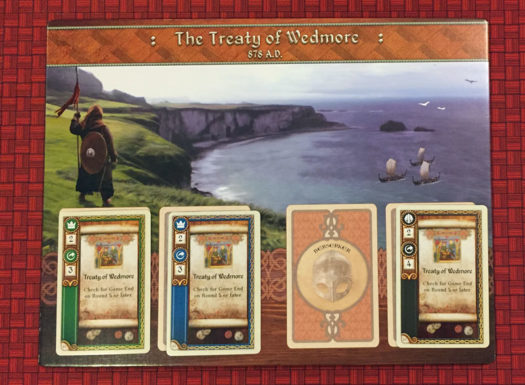
Can the whole family enjoy 878: Vikings – Invasion of England?
878: Vikings isn’t a game that everyone in the family will enjoy.
Sorry to disappoint you, but if you’re not yet aware, that’s the case with many board games.
And in our family, this is one of those games that only half of us enjoy playing.
The theme, game play, and strategies are all factors in whether or not someone in the family will enjoy playing.
Mom and Brooke don’t like battling games to begin with. Nor do they like games that take more than an hour to play. So they’re not interested from the get-go.
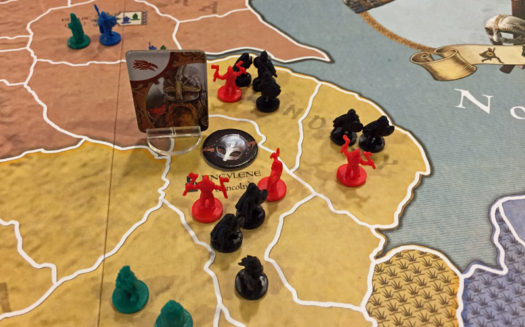
But for the boys, who like strategically involved battling games, it’s a hit.
Caleb has been on a Risk kick lately and frequently wants to play Risk: 2210. The boys also still love playing Smallworld and other area-control games. And we’re also looking forward to June for our Memoir ’44 dedicated Guys Game Night. So 878: Vikings and 1775: Rebellion are definitely games that deliver that type of fun for us.
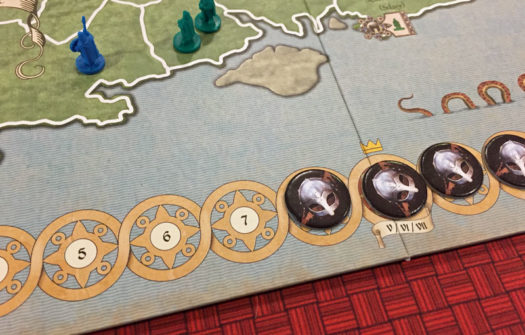
What we like about 878: Vikings – Invasion of England
One of the things we really like about 878: Vikings is the random, unknown turn order.
A number of games we enjoy include a changing turn order structure. However, in those games, there is a stage where turn order is determined (Power Grid, Risk Legacy). The order is set at the start of the round and each player can plan for when they’ll be up.
However, in 878: Vikings, the random draw of who goes next doesn’t happen until one faction completes their turn.
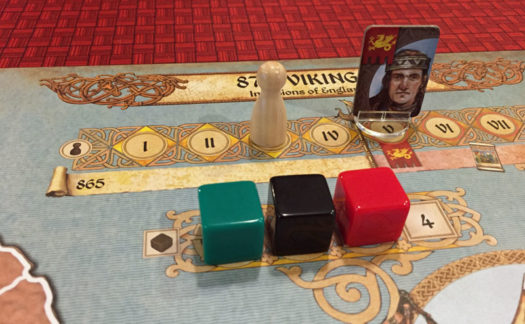
This means that in some rounds, both Viking factions could get a turn before either English faction goes. Or it could alternate evenly between factions. Or it can happen that one faction takes the first turn in one round and the last turn in the following round – with all 3 other factions getting to activate twice in between.
And that mechanic means players need to be on their toes with their strategy to be prepared for any options. It also makes every game play out differently. And that’s awesome.
We also love that each faction deck has a bunch of Event cards in it that are unique to that faction.
The first time playing the game, the event cards played by opponents come as a surprise that throws a twist into your plans. Thereafter, players get more adept at trying to anticipate the possibilities that may come from different factions during play. Either way, those cards add a wrinkle that keep each game and battle a bit tense.
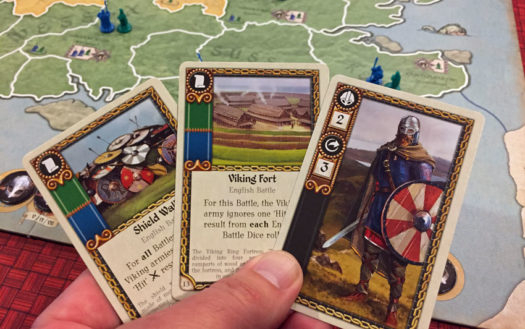
Another thing that’s cool with the game play is the 3 different outcomes of dice rolls. Sure there’s the standard Hit result that eliminates an enemy unit. But there’s also the Flee and Command results that keep players ready for anything. Just when you think you’ve got good numbers to attack, your units may get scared and run away (flee). Or depending on the battle, you may actually prefer to roll a Command result so you can move a unit into an adjacent territory that will be of better benefit later.
Academy Games has also adding in some really cool historical references that bring the game play to life.
Not only do they include a historical background section in the rulebook, they’ve also added historical tidbits to all the events cards. So while players are waiting for their turn and deciding which card to play next, they can read the small text at the bottom of the card to learn more about the historical setting.
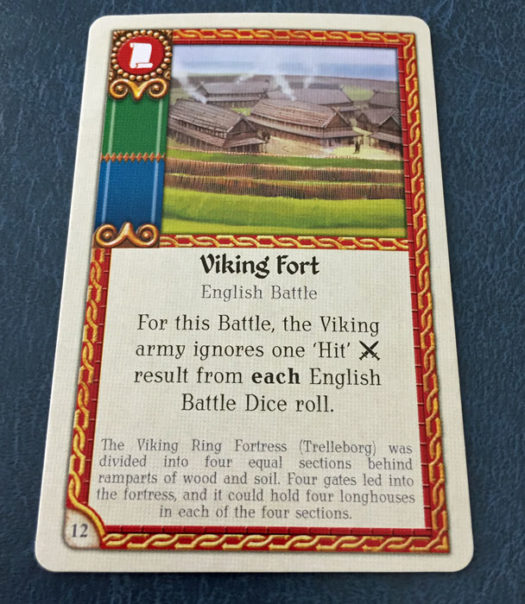
The rulebook also includes additional scenarios players can choose to play that mix up the game play a bit with specific win conditions and rules.
And there’s also a very cool reference sheet that reminds players of the phases in a turn as well as showing the different faction dice probabilities.
Overall, it’s a very well designed and produced game.
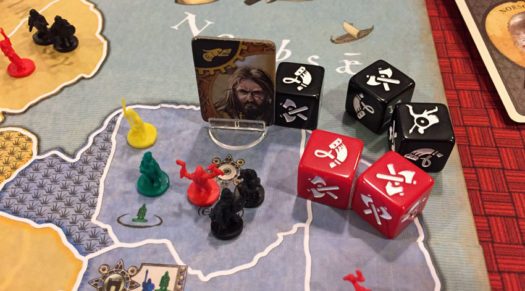
How does 878: Vikings score on our “Let’s Play Again” game meter?
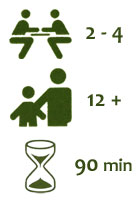 Even though we know how things turned out historically, every game can have a different result. And that’s what makes 878: Vikings – Invasion of England a fun game to play again and again.
Even though we know how things turned out historically, every game can have a different result. And that’s what makes 878: Vikings – Invasion of England a fun game to play again and again.
Because of the length of the game, it’s not one we’ve played back to back (nor do we anticipate doing so). But at the end of every game we feel satisfied with the game play and relive how the game played out. And that feeling also draws us back into wanting to play again soon.
We’re also still undecided on which game we prefer between 878: Vikings and 1775: Rebellion. The good news is that we don’t have to decide between the two. While the game flow is similar (random turn order, moving units, battling, etc.) the flavor of each is still unique.
The massive invading Vikings under the command of their leaders is a size-able force to reckon with. And it’s equally fun to be the invading Vikings as it is to defend the English homeland.
878: Vikings is another great Academy Games game that we highly recommend playing.
We’d like to thank Academy Games for a review copy of 878: Vikings – Invasion of England.



